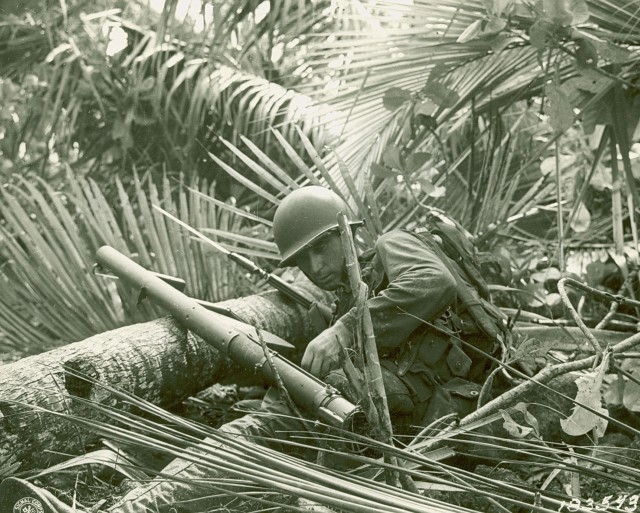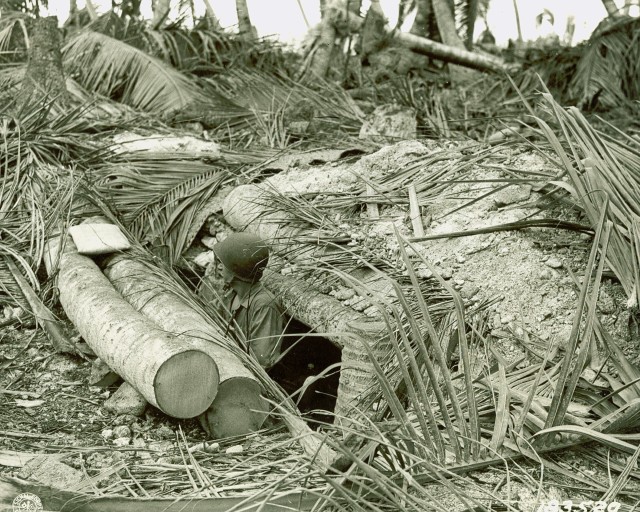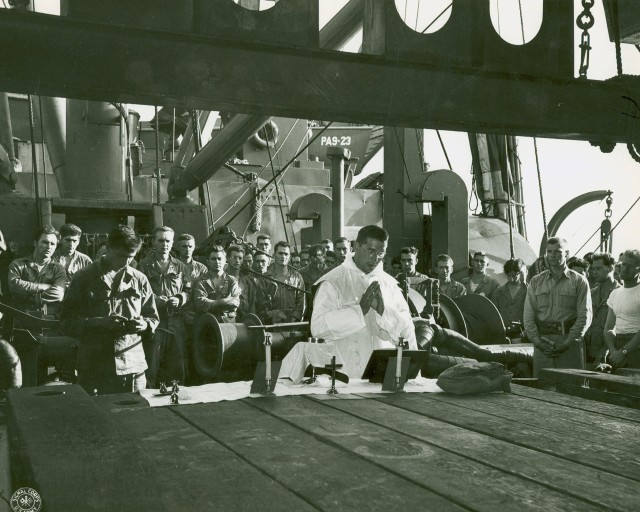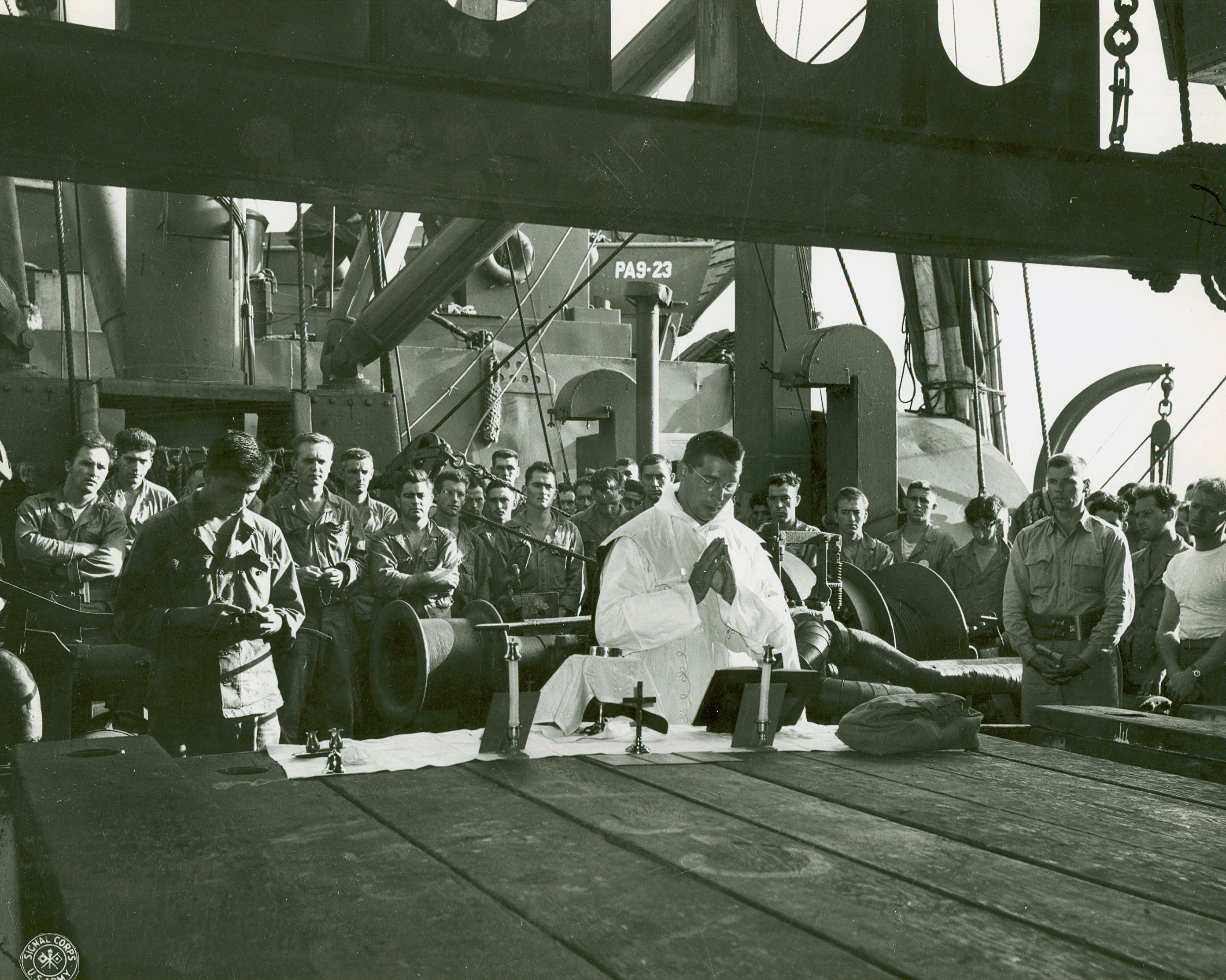On November 24, 1943 the capture of Makin Atoll in the Pacific was complete. The ArmyAca,!a,,cs 27th Infantry Division had defeated the Japanese after intense jungle combat. It was the quick thinking of a few infantrymen who saved the American positions. They fought off waves of Japanese attacks in the dark, early morning hours of November 23, 1943, in what they christened as the Aca,!A"Saki Night.Aca,!A?
On the morning of November 20, Major General Ralph C. SmithAca,!a,,cs 27th Infantry Division landed on Makin Atoll while the 2nd Marine Division landed on the nearby atoll of Tarawa. The 165th Regimental Combat Team (RCT) of the 27th consisted of three Battalion Landing Teams (BLT). The 1st and 3rd BLTs landed at Red Beach on the western end of the island. The 2nd BLT came ashore on the northern coast, and moved to the center of the island to cut off an enemy retreat.
At Red Beach, soldiers encountered little resistance, and the 1st and 3rd BLT moved forward to link up with the 2nd at the center of the island. The 2nd BLT encountered automatic weapons fire from Japanese defenders and suffered three casualties but otherwise faired well pressing into the jungle. Aca,!A"Smoking out snipers in the trees,Aca,!A? recalled 1st Sgt. Pasquale Fusco Aca,!A"was the worst part of itAca,!A|and it made our advance very slow.Aca,!A?
After two days of fighting secluded positions of Japanese resistance, the 3rd BLT relieved the 2nd BLT as the main element on the island. As the men from I, K, L and M (weapons) Companies settled down on the evening of November 22, they were more concerned about the mosquitoes than the Japanese. Little did they realize that a mere few hundred yards away, Japanese soldiers were preparing for their Aca,!A"BanzaiAca,!A? attack by becoming intoxicated with Aca,!A"saki,Aca,!A? or rice wine.
At 1900 hours, the Japanese began screaming Aca,!A"Heil HitlerAca,!A? or Aca,!A"Blood for the emperorAca,!A? from positions 20 yards away, but the GIAca,!a,,cs held their fire. After a series of grenade explosions, Sgt. Edward N. Pasdertz looked up, seeing and then killing Japanese soldiers only six-feet away from his foxhole. To the right, Pvt. Randolph Slatner raised his head to see six Japanese with fixed bayonets charging his position. Before the machine gun crew could set up, Pvt. Slatner stood up, firing his Browning Automatic Rifle from his hip. The six bayonets went down with their users.
At the same time, PFC Elio Bizari raised his head in time to notice a Japanese figure with a samurai sword lunging towards him. As Bizari froze in horror Pvt. Gerald Heck fired rounds into the attacker but failed to kill him. Pierced, Bizari removed the sword from his own chest; then taking up his trench knife, he killed the Japanese officer.
Down the line, PFC George Antolak stood to fire at an enemy soldier only four feet from his foxhole. Instead, he threw his rifle at his foeAca,!a,,cs face, causing both of them to fall into a foxhole. PFC Carl Samuels rushed over, removed his helmet and beat the Japanese soldier over the head. Antolak broke lose and ran the Japanese officer through with the manAca,!a,,cs own sword.
Similar attacks continued along I & K Company line, but the perimeter held. The following day the 3rd BLT delivered the final blow to the Japanese on Makin, thus ending the operation. Throughout the island campaign, and especially on that one intoxicating night, the 27th Division suffered 59 dead and 150 wounded soldiers. Their steadfast and sober bravery helped to pave the way to Tokyo and victory.
EditorAca,!a,,cs Note: Our guest contributor, Parker Chapman, served as a student volunteer at the Army Heritage and Education Center, summer 2008. He is a member of the Class of 2009, and a history major at The Citadel: The Military College of South Carolina, located in Charleston.
Related Links:
USAMHI Bibliography: 27TH INFANTRY DIVISION
USAMHI Bibliography: 165TH INFANTRY REGIMENT
USAMHI Bibliography: GILBERT ISLANDS, NOV 1943: TARAWA & MAKIN










Social Sharing